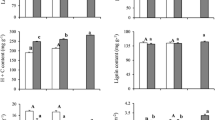Abstract
Diurnal changes in net photosynthetic rate (PN), evapotranspiration rate (ET) and water use efficiency (WUE=PN/ET) of field grown chickpea (Cicer arietinum) L. cv. H-355 were studied from the vegetative phase through maturirty at Haryana Agricultural University Farm, Hissar, India. The maximum photosynthetic rate (PN max) increased from the initial vegetative phase to pod formation and declined at a rapid rate from pod filling to maturity. The response of PN to photosynthetic photon flux density (PPFD) (400–700 nm) was temperature-dependent during the day, i.e. on cool days the PN rates were lower for certain quanta of PPFD during the first half than during the second half of day, and vice versa on warm days. ET was affected both by crop cover and evaporative demand up to flowering, but thereafter it was independent of crop cover and followed the course of evaporative demand. ET was related to air temperature during the day while PN was related to PPFD. There was a lag of two to three hours between PNmax (around noon) and ETmax (around 2 p.m.). WUE increased from the vegetative stage through flowering but decreased thereafter to maturity.
Similar content being viewed by others
Abbreviations
- DAS:
-
days after planting
- ET:
-
evapotranspiration
- LAI:
-
leaf area index
- PAR:
-
photosynthetically active radiation (in figures) is equivalent to PPFD (see below)
- PN:
-
net photosynthetic rate
- PPFD:
-
photosynthetic photon flux density
- WUE:
-
water use efficiency (= PN/ET)
References
Campbell D, Degenhardt D and Kondra Z (1978) Breeding for early maturity in summer type Brassica napus. Proc V Intl Rapeseed Conf, Malmo, Sweden. Vol 1, pp 52–55
Downes RW (1972) Physiological aspects of sorghum adaptation. In Rao NGP and House LR, eds., Sorghum in seventies, pp 265–274. New Delhi: Oxford & I.B.H
Johnson RC, Witters RE and Ciha AJ (1981) Apparent photosynthesis, evapotranspiration and light penetration in two contrasting hard red winter wheat canopies. Agron J 73: 419–22
Kramer PJ (1980) The role of physiology in crop improvement. In: Staples RC and Kuhr RJ (eds) Linking research to crop production, pp 51–62. New York: Plenum Press
Lush WM and Rawson HM (1979) Effects of deomestication and region of origin on leaf gas exchange in cowpea (Vigna unguiculata (L)Walp) Photosynthetica 13: 419–29
Pate JS (1978) Pea. In: Evans ET (ed) Crop physiology, pp 191–224. Cambridge: Cambridge Univ Press
Rawson HM and Constable GA (1980) Carbon production of sunflower cultivars in field and controlled environment. I. Photosynthesis and transpiration of leaves, stems and heads. Austral J of Plant Physiol 7: 555–73
Rawson HM, Begg JE, Woodward RG (1977) The effect of atmospheric humidity on photosynthesis, transpiration and water use efficiency of leaves of several plant species. Planta 134: 5–10
Sheldrake AR and Saxena NP (1979) Growth and development of chickpeas under progressive moisture stress. In: Mussel H and Staples RC (eds) Stress physiology in crop plants, pp 465–83. New York: Wiley-Interscience
Singh H and Yadav CK (1980) Gene action and combining ability for seed yield, flowering and maturity in rape seed. Indian J of Agric Sci 50: 655–58
Singh DP, Rawson HM and Turner MC (1982) Effect of radiation, temperature and humidity on photosynthesis, transpiration and water use efficiency of chickpea (Cicer arietinum L.). Indian J Plant Physiol 25: 32–39
Singh DP, Singh P., Singh P, Sharma HC and Singh M (1982) Effect of crop geometry and irrigation management on growth, evapotranspiration and water use efficiency of chickpea. Proc IV Afro-Asian Conf of ICID, Vol 1, pp 489–504. Lagos, Nigeria
Threshow M (1970) Environment and plant response, pp51–62. New York: McGraw-Hill
Turner NC (1982) The role of shoot characteristics in drought resistance of crop plants. In: Drought Resistance in Crops with emphasis on rice, pp 115–124. Philippines: IRRI
Author information
Authors and Affiliations
Rights and permissions
About this article
Cite this article
Singh, D.P., Peters, D.B., Singh, P. et al. Diurnal patterns of canopy photosynthesis, evapotranspiration and water use efficiency in chickpea (Cicer arietinum L.) under field conditions. Photosynth Res 11, 61–69 (1987). https://doi.org/10.1007/BF00117674
Received:
Revised:
Accepted:
Issue Date:
DOI: https://doi.org/10.1007/BF00117674



